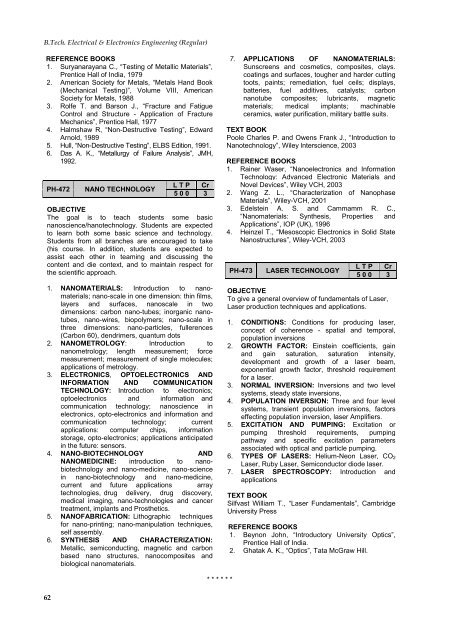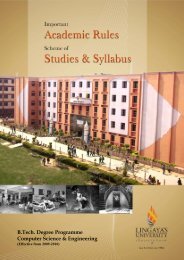Electrical and Electronics - Lingaya's University
Electrical and Electronics - Lingaya's University
Electrical and Electronics - Lingaya's University
You also want an ePaper? Increase the reach of your titles
YUMPU automatically turns print PDFs into web optimized ePapers that Google loves.
B.Tech. <strong>Electrical</strong> & <strong>Electronics</strong> Engineering (Regular)REFERENCE BOOKS1. Suryanarayana C., ―Testing of Metallic Materials‖,Prentice Hall of India, 19792. American Society for Metals, ―Metals H<strong>and</strong> Book(Mechanical Testing)‖, Volume VIII, AmericanSociety for Metals, 19883. Rolfe T. <strong>and</strong> Barson J., ―Fracture <strong>and</strong> FatigueControl <strong>and</strong> Structure - Application of FractureMechanics‖, Prentice Hall, 19774. Halmshaw R, ―Non-Destructive Testing‖, EdwardArnold, 19895. Hull, ―Non-Destructive Testing‖, ELBS Edition, 1991.6. Das A. K., ―Metallurgy of Failure Analysis‖, JMH,1992.PH-472NANO TECHNOLOGYL T P Cr5 0 0 3OBJECTIVEThe goal is to teach students some basicnanoscience/hanotechnology. Students are expectedto learn both some basic science <strong>and</strong> technology.Students from all branches are encouraged to take(his course. In addition, students are expected toassist each other in teaming <strong>and</strong> discussing thecontent <strong>and</strong> die context, <strong>and</strong> to maintain respect forthe scientific approach.1. NANOMATERIALS: Introduction to nanomaterials;nano-scale in one dimension: thin films,layers <strong>and</strong> surfaces, nanoscale in twodimensions: carbon nano-tubes; inorganic nanotubes,nano-wires, biopolymers; nano-scale inthree dimensions: nano-particles, fullerences(Carbon 60), dendrimers, quantum dots2. NANOMETROLOGY: Introduction tonanometrology; length measurement; forcemeasurement; measurement of single molecules;applications of metrology.3. ELECTRONICS, OPTOELECTRONICS ANDINFORMATION AND COMMUNICATIONTECHNOLOGY: Introduction to electronics;optoelectronics <strong>and</strong> information <strong>and</strong>communication technology; nanoscience inelectronics, opto-electronics <strong>and</strong> information <strong>and</strong>communication technology; currentapplications: computer chips, informationstorage, opto-electronics; applications anticipatedin the future: sensors.4. NANO-BIOTECHNOLOGY ANDNANOMEDICINE: introduction to nanobiotechnology<strong>and</strong> nano-medicine, nano-sciencein nano-biotechnology <strong>and</strong> nano-medicine,current <strong>and</strong> future applications arraytechnologies, drug delivery, drug discovery,medical imaging, nano-technologies <strong>and</strong> cancertreatment, implants <strong>and</strong> Prosthetics.5. NANOFABRICATION: Lithographic techniquesfor nano-printing; nano-manipulation techniques,self assembly.6. SYNTHESIS AND CHARACTERIZATION:Metallic, semiconducting, magnetic <strong>and</strong> carbonbased nano structures, nanocomposites <strong>and</strong>biological nanomaterials.7. APPLICATIONS OF NANOMATERIALS:Sunscreens <strong>and</strong> cosmetics, composites, clays.coatings <strong>and</strong> surfaces, tougher <strong>and</strong> harder cuttingtoots, paints; remediation, fuel ceils; displays,batteries, fuel additives, catalysts; carbonnanotube composites; lubricants, magneticmaterials; medical implants; machinableceramics, water purification, military battle suits.TEXT BOOKPoole Charles P. <strong>and</strong> Owens Frank J., ―Introduction toNanotechnology‖, Wiley lnterscience, 2003REFERENCE BOOKS1. Rainer Waser, ―Nanoelectronics <strong>and</strong> InformationTechnology: Advanced Electronic Materials <strong>and</strong>Novel Devices‖, Wiley VCH, 20032. Wang Z. L., ―Characterization of NanophaseMaterials‖, Wiley-VCH, 20013. Edelstein A. S. <strong>and</strong> Cammamm R. C.,―Nanomaterials: Synthesis, Properties <strong>and</strong>Applications‖, IOP (UK), 19964. Heinzel T., ―Mesoscopic <strong>Electronics</strong> in Solid StateNanostructures‖, Wiley-VCH, 2003PH-473LASER TECHNOLOGYL T P Cr5 0 0 3OBJECTIVETo give a general overview of fundamentals of Laser,Laser production techniques <strong>and</strong> applications.1. CONDITIONS: Conditions for producing laser,concept of coherence - spatial <strong>and</strong> temporal,population inversions2. GROWTH FACTOR: Einstein coefficients, gain<strong>and</strong> gain saturation, saturation intensity,development <strong>and</strong> growth of a laser beam,exponential growth factor, threshold requirementfor a laser.3. NORMAL INVERSION: Inversions <strong>and</strong> two levelsystems, steady state inversions,4. POPULATION INVERSION: Three <strong>and</strong> four levelsystems, transient population inversions, factorseffecting population inversion, laser Amplifiers.5. EXCITATION AND PUMPING: Excitation orpumping threshold requirements, pumpingpathway <strong>and</strong> specific excitation parametersassociated with optical <strong>and</strong> particle pumping.6. TYPES OF LASERS: Helium-Neon Laser, CO 2Laser, Ruby Laser, Semiconductor diode laser.7. LASER SPECTROSCOPY: Introduction <strong>and</strong>applicationsTEXT BOOKSilfvast William T., ―Laser Fundamentals‖, Cambridge<strong>University</strong> PressREFERENCE BOOKS1. Beynon John, ―Introductory <strong>University</strong> Optics‖,Prentice Hall of India.2. Ghatak A. K., ―Optics‖, Tata McGraw Hill.* * * * * *62
















